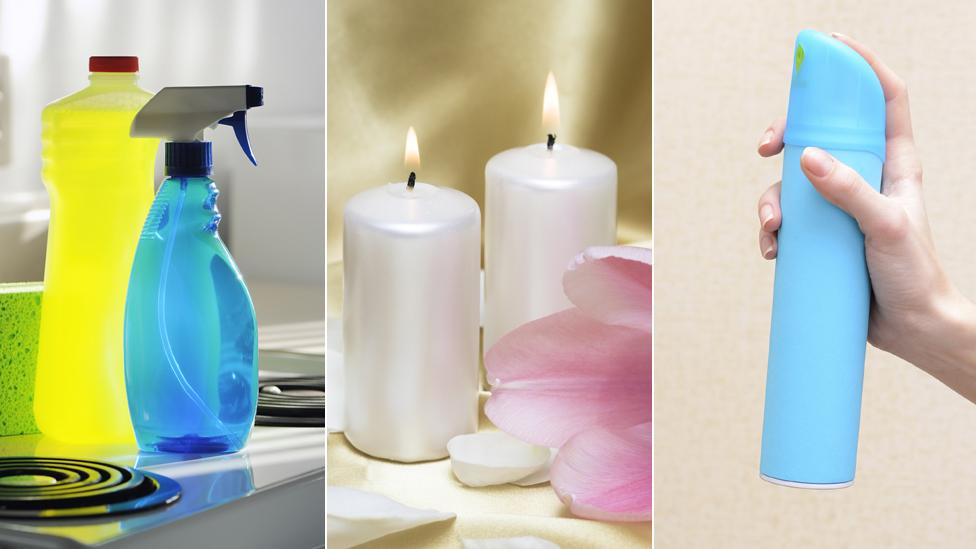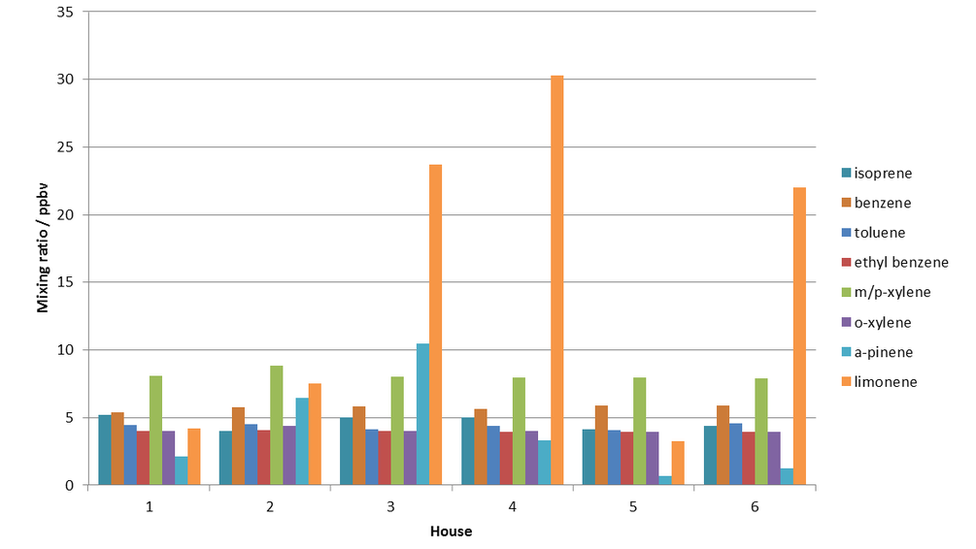Is there a danger from scented products?
- Published

It's the time of year when we generally keep our doors and windows shut and maybe light a few scented candles to brighten up the long dark evenings. But is there a potential danger, asks Saleyha Ahsan.
Lots of people use air fresheners and body sprays - almost all of which contain what the ingredients listing coyly describes as "perfume".
All in all, it adds up to quite a fragranced atmosphere - and with little airflow in our increasingly-insulated homes, have you ever wondered what happens to all these perfume chemicals? Well, it seems they could be reacting in the air forming a potentially dangerous cocktail.
The levels of perfume chemicals are regulated inside products, but what we then do with those products is entirely up to us. No one measures air quality inside our houses. Prof Alastair Lewis of the National Centre for Atmospheric Science at the University of York and the team from Trust Me, I'm a Doctor set out to do just that.
Firstly he measured the levels of a whole range of "volatile organic chemicals" (VOCs) in six similar, modern houses in York over the course of five days.
The stand-out chemical - varying most among the houses - was limonene. It's commonly used to give a citrus smell. In the three houses that used the most cleaning products, limonene levels were so high that Prof Lewis even had to adjust the sensitivity of the monitors.

The York study

The amount of different volatile organic compounds measured in the air in six modern houses in York - benzene (brown) is generally coming in from outdoor vehicle pollution; alpha-pinene (light blue) is a pine perfume used in many cleaning products, and limonene (orange) is a citrus scent, very widely used in scented products
Three of the households had the highest levels of limonene, which corresponded to the amount of household products and scented candles they used

That in itself is no cause for panic. Limonene is not a chemical that poses a big hazard to health - in fact it is also used as a flavouring in foods. However, once sprayed into our houses, it doesn't stay as limonene for long.
Back in the laboratory, Prof Lewis analysed its reactivity, and discovered that on exposure to ozone - which is present in the air all around us - every two molecules of limonene could produce one molecule of another chemical, formaldehyde.
Having lots of formaldehyde in our houses is quite a different prospect. Since the 1980s, links have been established between formaldehyde and cancer, and since 2011 it's been listed as a known human carcinogen.
It's present in some furniture, and is created by burning cigarettes or by gas stoves. But given the very high levels of limonene discovered in some of our houses, we wanted to measure formaldehyde in them too.
We discovered that it correlated with the levels of limonene, in line with Prof Lewis's findings that it was created from limonene. It seems that while enjoying the aroma of fragranced candles, plug-ins, air fresheners and cleaning products we are increasing our exposure to a serious nasty.

Find out more

Trust Me I'm A Doctor, presented by Dr Saleyha Ahsan (pictured) and others, is broadcast on Wednesdays at 21:00 GMT on BBC Two - catch up on BBC iPlayer

An obvious solution is to open the doors and windows more, but that's not altogether practical in the winter, and goes against our recent energy efficiency measures. There might be, though, a more ingenious solution.
Among the reams of research done over the decades on chemicals in the air, there is a small collection of papers about the pollution-busting effects of houseplants. In laboratories, many plants have been shown to absorb particular chemicals, including formaldehyde, but very few studies appear to have taken this research out into the real world.

To put the practicality of this solution to the test, each house in the study took in four specially chosen houseplants for six weeks, while Prof Lewis continued to record the levels of both limonene and formaldehyde. Over those four weeks, the levels of limonene in all six houses rose - probably because over those weeks winter truly set in. Doors and windows were closed, and scented candles came out - pushing limonene in one house up to the highest levels Prof Lewis had ever recorded.
The house plants were clearly not having a significant effect on limonene levels. But then came the formaldehyde readings. In all three houses measured, while the limonene levels went up, the formaldehyde levels came down. Although it's a tiny sample size, it certainly suggests that perhaps the plants were helping absorb the toxic formaldehyde.
Which plants are the best absorbers?, external Well, several have come up trumps in laboratory tests. English ivy (Hedera helix) is apparently a good all-round absorber, while geraniums, lavender and many ferns are particularly good at absorbing formaldehyde, external. So, perhaps the best fragrance for all our homes isn't fresh citrus but natural lavender from a houseplant.
Trust Me, I'm A Doctor continues on BBC Two at 20:00 BST on Wednesday 13 January - or watch on BBC iPlayer.
Subscribe to the BBC News Magazine's email newsletter to get articles sent to your inbox.